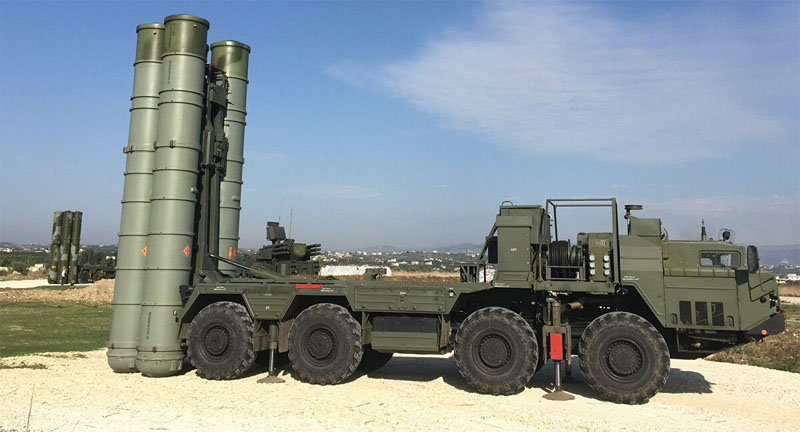S-500 Prometheus: ‘Killer Of F-35’ Has Undergone Combat Missile Trials And Is Coming Soon
Moscow (Sputnik) Jul 14, 2021
File image of an early model S-500 during its current development program.
Speaking to the Russian news outlet Krasnaya Zvezda last week, Major General Babakov elaborated that the S-500 has been developed as a completely new generation of anti-aircraft systems aimed at taking down medium-range ballistic missiles, and, if necessary, intercontinental ballistic missiles in the final stage of their flight path. In addition to this, the S-500 is capable of destroying hypersonic aircraft and unmanned aerial vehicles, according to him.The new generation S-500 Prometheus air defence system developed by the Russian arms company Almaz-Antey, the same group that produced the S-300 and S-400, has successfully completed a series of tests including combat missile launches, according to the Commander of the Missile Defence Troops of the Russian Air Force, Maj. Gen. Sergei Babakov.
“The S-500 air defence system is capable of destroying hypersonic weapons of all modifications, including in near space, in addition to aerodynamic and ballistic targets, which makes it possible to say with confidence that this system is unique”, Maj. Gen. Babakov said.
Russia’s new defence weapon can reportedly engage enemy ballistic missiles at a range of up to 600 kilometres and aircraft at about 500 kilometres.
The military official explained that the combat drills involved firing at targets possessing technical specifications similar to modern aerospace attack weapons or those with more advanced capabilities.
According to the major general, anti-aircraft missile crews hone their skills by intercepting both small-sized, low-flying, low-speed objects that mimic unmanned aerial vehicles and high-altitude, high-speed targets that mimic hypersonic missiles.
Moreover, the Russian Air Force has also taken into account the experience gained during the aerial campaign in the Syrian Arab Republic. All incidents of using weapons and anti-aircraft missile military equipment is being carefully studied and employed during the drills, Babakov highlighted.
Russia’s military schools and academies of the Ministry of Defence as well as the country’s technical universities are training specialists for anti-aircraft missile crews in the nation’s Air Force, the major general noted, adding that this year over 1,000 graduates have taken up their duties in this branch of the armed forces of the Russian Federation.
S-500: Successor to S-400 or Entirely New Weapon?
Last December, Russian Deputy Defence Minister Alexei Krivoruchko revealed that the S-500 missile system and the Voronezh long-range early-warning radars could enter service as early as in 2021, following the completion of trials.
Long-range early warning radars are the backbone of any missile defence complex. The Voronezh family, which monitors airspace against ballistic missile and aircraft attacks has three variations: Voronezh-M (metre band), Voronezh-DM (decimeter band), and Voronezh-SM (centimeter band). All three operate in a single system making it capable of determining target parameters and type more precisely.
In early April 2021, Almaz-Antey signalled that the new S-500 air defence system was about to wrap up trials this year. It is expected that the new state-of-the-art Prometheus system will be delivered to the Russian Armed Forces once its combat tests are completed. In the future, the unique long-range air defence complex is due to become become the cornerstone of a unified national air and missile defence system.
On 28 June, during a meeting with top graduates from military schools and academies of the Ministry of Defence, Russian President Vladimir Putin stated that the S-500 Prometheus anti-aircraft system, Sarmat intercontinental ballistic missile, and Zircon ship-based hypersonic missiles would soon be put on combat duty along with other advanced military complexes.
The development of the S-500 prompted a heated debate among western military observers who particularly raised the alarm over the system’s reported ability to successfully thwart the US aircraft’s low-observable (LO) technology: “Of all the Kremlin’s latest weapons projects, the S-500 is among Russia’s most direct and potent answers to US fifth-generation stealth fighter jets like Lockheed Martin’s F-35 Lightning II and F-22 Raptor”, the National Interest underscored on 27 May 2021.
“S-500s would be ideal for providing regional ballistic missile defence along Russia’s European borders with NATO”, the Drive wrote in May 2018. “It is in many ways roughly analogous to the US-made Terminal High Altitude Area Defence system, or THAAD, though the goal is clearly to offer flexibility to respond to more conventional aerial threats, as well”.
According to foreign observers, the S-500 can’t be called a pure “successor” to the S-400: it’s an entirely new weapon, designed to fulfill a broader set of strategic tasks.
Source: RIA Novosti
Courtesy: Spacewar

